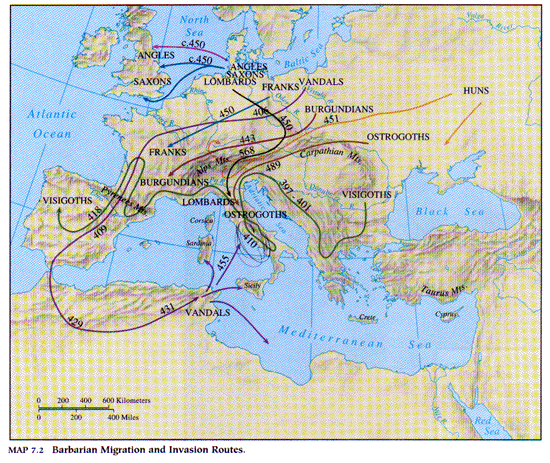The pressure from ‘barbarians’ (mostly Germans) which the Roman Empire had experienced from the late second century became more intense in the late fourth century. This Volkerwanderung (wandering of the peoples) involved unstable amalgams of diverse groups, many of whom settled gradually and relatively peacefully. The pressure of steppe nomads such as the Huns from c. 370 played a role, but probably more important were rivalries among the Germanic peoples, the formation of confederacies under aggressive military leaders from the third century and the opportunities presented to booty hungry warleaders and their retinues by Rome’s political, military and financial weaknesses and the
increasing alienation of Roman provincials from centralized rule.

The first serious case of Germanic penetration occurred after 376, as Visigothic and Ostrogothic tribes living beyond the Danube sought refuge as Roman allies (foederati) within the empire. Tension led to the battle of Adrianople in which a largely Visigothic force defeated a Roman army and killed the emperor Valens. Although a treaty was soon arranged the Visigoths continued to ravage Greece and Illyricum until, in 402, they entered Italy under the leadership of Alaric. A cat-and-mouse game took place while the imperial government in Ravenna prevaricated in the face of Gothic demands for land and gold.
Finally Alaric’s exasperation led to the sack of Rome in August 410—an enormous blow to
Roman morale. Alaric died soon afterwards and his brother-in-law Ataulf led the Goths to southern Gaul, where they were recognized as foederati by a treaty in 416. Under their kings Theodoric I and II and Euric, they built up a powerful state based on Toulouse which had generally good relations with the Roman aristocracy and established overlordship in Spain.
The German peoples who had remained north of the Danube (Heurules,Gepids, Rugi, Skiri and Ostrogoths) became subjects of the Huns, who built up a tributary empire under Attila (434–53). While launching regular attacks on the east Roman provinces in the Balkans, Attila remained friendly with Aetius, the dominant force in the west, until he was induced to launch inconclusive raids into Gaul (checked by his defeat at Chalons in 451) and northern Italy. The collapse of the Hun empire following Attila’s death in 453 led to renewed pressure by Germanic bands (Ostrogoths, Rugi and others) on the Danube frontier.
Meanwhile northern Gaul had been thrown into confusion by the rupture of the Rhine frontier in late 406 by a mixed barbarian force dominated by Vandals, Suevi and Alans. While some Alans became Roman allies in Gaul, others joined the Vandal invasion of Spain in 409. The Suevi set up a robber kingdom based on Galicia which lasted until 585. In the face of Visigoth pressure the Vandals sailed to Africa in 429 and were granted the western provinces by a treaty of 435. Their able king, Geiseric, seized Carthage in 439, occupied the rest of Roman Africa and launched a series of lucrative naval raids, occupying Sicily, Sardinia and Corsica and sacking Rome in 455. Following his death in 477
the aggressive and confiscatory policies towards the Roman aristocracy and the Catholic Church gave way to a generally more conciliatory and Romanizing regime.

The collapse of the Rhine frontier in 406/7 had wide repercussions. Britain saw its Roman garrison withdrawn and the assumption of power by rival British chieftains until the Anglo Saxon invasions in the late 440s. The Burgundians were permitted to set up a kingdom on the upper Rhine in 413. Transferred as federates to the Jura/Lake Geneva area in 443, they built up a Romanized kingdom incorporating the Lyon and Vienne areas from 457. Along the middle and lower Rhine groups of Franks became powerful and attacked cities such as Cologne and Trier. In northern Gaul Roman rule was undermined by obscure rivalries between usurping generals, Bretons, peasant rebels (Bagaudae), Alans and the sub-Roman regimes of Aegidius and his son Syagrius based on Soissons (c. 456–86). The long-term beneficiary of this power vacuum was the Salian Frank dynasty of Childeric (d. 481) and his son Clovis, who gradually expanded from their original centre of Tournai by conquering or allying themselves with rival bands of Franks, including established laeti (soldier-farmers).
End of Part 1
MORE TO COME SO STAY TUNED @ http://www.triond.com/users/celeres





1 komentari:
War is a fascinating subject. Despite the dubious morality of using violence to achieve personal or political aims. It remains that conflict has been used to do just that throughout recorded history.
Your article is very well done, a good read.
Objavi komentar